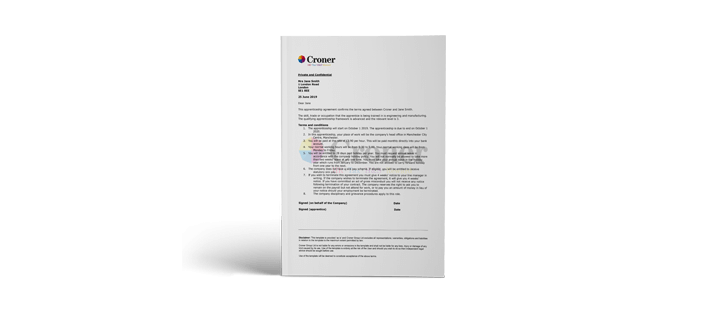The key to success for every business is its people. To ensure you get the right ones for your business, you must get the recruitment process right.
You could face claims of discrimination, and costly fines, if you don’t follow the correct procedure.
It’s up to you to make your procedure work. One way to do this is to follow the hiring process steps outlined in this article. This will help you avoid common pitfalls and keep your hiring activities effective.
In this article, we’ll look at the recruitment process steps, and break it down step by step, providing tips along the way. Need more support? Call us on 01455 858 132 to make sure you get your hiring process right.
What is the recruitment process?
When you need new staff, you draft a job description and begin hiring. This procedure—from the steps in the employee selection process to the individual’s induction—are all parts of the recruitment process.
There are many methods and many routes you can take to attract the talent you need. Whether you hire locally, or use a recruiting website, there are common practices that will ensure the process is efficient and effective.
Handling the process poorly can result in a long, drawn-out exercise. In extreme cases, you may even face claims of discrimination.
What are the steps in the recruitment process?
Every business is different, so each one will hire differently. One of the most popular approaches is called the “recruitment cycle”.
This is a holistic approach to the process. It also means you will have the most involvement.
You can oversee it yourself, or it can be a human resource-led recruitment process. Although it tends to involve multiple people or departments, there is usually one person who looks after all activities.
This type of hiring process is broken down into seven steps, we’ve detailed the stages of the recruitment process below:
1. Identifying need
The first step of the hiring process is deciding what role needs to be filled. You can’t find what you need if you aren’t sure what you need in the first place. Where are the gaps in your current team?
Will a role soon become vacant? Analyse the job specifications and identify the knowledge, skills and experience needed for the role.
Our key piece of advice at this stage is this: be proactive. Don’t wait until an employee has left, or a new project desperately needs another person working on it. Doing this will mean you rush to find a replacement and may not get the best fit for the role.
2. Job description
Perhaps the most crucial of the seven recruitment steps is the job description. This is critical in attracting the right people, as well as ensuring the right responsibilities are covered. Start with an outline of key responsibilities and work your way to a full description from there.
A job description must include the following:
- Title.
- Duties & responsibilities.
- Qualifications & skills.
- Location.
- Compensation, perks & benefits.
Of course, this is just the bare bones. To create a truly great job description, you should make the content emotive and as jargon-free as possible.
3. Talent search
You’ve found a gap in your current team. You’ve written a comprehensive job description. Now, you need to get the word out and attract the right talent.
No doubt you’re aware of the many different channels you can use to hire. Some of them include: advertisements, job portals, and social media websites.
Why not use multiple channels in your search? What works for one role may not be the best path for another. The recruitment process in human resource management is different to the process for finding construction workers.
And don’t forget to advertise internally too. You might find that the person you’re looking for is in the next room over, or a floor below.
4. Selection process
As soon as you receive applicants, you can begin the employee selection process. This is broken down into two stages: shortlisting and assessment.
First, shortlisting. Decide how many candidates you want to interview. Next, make a list of essential criteria, such as a certain level of qualifications or experience.
You can narrow this even further by adding “desirable” criteria.
Now, go through your list of candidates, and whittle it down to those you want to interview. Use your essential criteria to remove any applicants who don’t meet your requirements. Make the list even smaller using your “desirable” criteria.
Remember, it’s illegal to discriminate against candidates based on protected characteristics, such as age, disability, or sex. You must only review information relevant to their ability to perform the role.
Next, assessment. This stage is a little more subjective. It means looking over the finer details of the CV and cover letter to glean as much information as possible about the candidate. Pick out career gaps, learn from the candidates interests and hobbies, review the competence of their cover letter.
Then, once you have all the information you need, invite applicants to an interview.
5. Interviewing
Like the previous couple of steps, the interview process differs depending on your preference. You can perform the interview in person, via video call, or over the phone. You can conduct the interviews in multiple stages, or just have a single meeting.
Whatever your approach may be, remember that the interview is your final chance to screen the candidate for suitability. Make sure you ask the questions most appropriate to find out if they have the necessary experience and will be a good fit. Keep your questions direct, rather than abstract, and make sure they are relevant to the role.
Finally, remember that an interview is a two-way process. The candidate will also be assessing whether your company is a suitable fit for them, so answer their questions openly and honestly. Be respectful and take the opportunity to sell them on the role.
6. Offer employment
By this stage, you should have a good idea who you want to employ. Before you send a letter offering them the role however, there are a couple of things you should do:
- Check their references.
- Do a final assessment of their CV.
Chances are, if anything was amiss, you would’ve spotted it already. However, it’s always worth checking if something has fallen through the cracks.
Once you’re happy however, you should send a job offer letter.
7. Induction
The last of the job hiring process steps is the introduction and induction of the new employee. Under UK employment law, the individual becomes an official employee from the day they accept an “unconditional” job offer. That means they have all of the employment rights an employee is entitled to.
The induction process is key to employee retention. Making the individual feel settled as soon as possible has lots of benefits. Providing a welcome kit and introducing them to key staff in the business is a great start. Providing all the necessary documents as quickly as possible and organising future meetings will also prove beneficial.
Remember to check in regularly with the new starter to discuss any issues they’re facing and help them settle.
You should include a probation period in the employee’s contract. This is essentially a trial period to make sure your new hires are performing as you expected when offering the role.
How do I ensure the best recruitment process?
The above is a steadfast approach to recruiting, but what are the best recruitment process steps you can take to ensure it is fast and effective?
Our first tip would be to set a schedule for each stage of the procedure. This will ensure you get the people you need when you need them. If you share the schedule with the candidates, this will also keep them engaged in the process.
If you haven’t already, a great way to encourage recruitment internally and externally, is to implement an employee referral program. This leads to a wider pool of applicants, and rewards your staff too.
Finally, clearly define who in your organisation is responsible for the recruitment process. It’s often worth getting multiple people involved with the selection and interviewing process, but there should ultimately be one decision-maker. If everyone is clear on their role, things will run smoothly.
Expert support on recruitment with Croner
The recruitment process is time-consuming, and can be expensive. It’s important to make sure you follow the correct procedure. Or you risk hiring the wrong people, or worse, facing discrimination claims.
If you need further guidance or want a second opinion on recruitment, we’re here to help.
Croner’s experts deal with HR queries every day, and can provide you with the support you need to hire the right talent for your business.
Speak to one of our consultants today on 01455 858 132.























